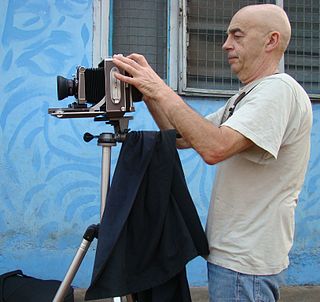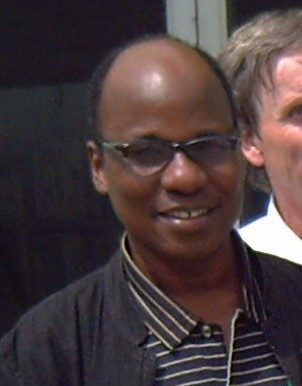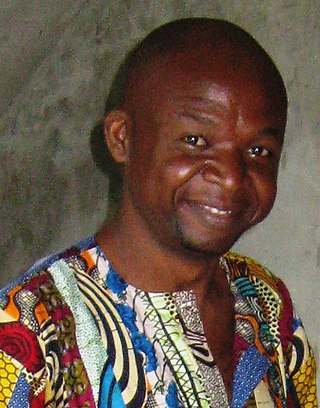
Simon Njami (born 1962 in Lausanne) is a writer and an independent curator, lecturer, art critic and essayist.

Simon Njami (born 1962 in Lausanne) is a writer and an independent curator, lecturer, art critic and essayist.
Njami published his first novel "Cercueil et Cie" in 1985, followed by "Les Enfants de la Cité" in 1987, and "Les Clandestins" and "African Gigolo" in 1989. He has written biographies of James Baldwin and Léopold Sédar Senghor, several short texts, scripts for cinema, and documentary films.
Njami is the co-founder of Revue Noire, [1] a journal of contemporary African and extra-occidental art, and he was visiting professor at the University of California, San Diego.
After conceiving the Ethnicolor Festival in Paris in 1987, Njami curated many international exhibitions being among the first ones to think and show African contemporary artists work on international stages. He has served as artistic director of Bamako Encounters, the African Photography Biennale, from 2001 to 2007. [2] [3] Njami is the curator of "Africa Remix", showed in Düsseldorf (Museum Kunstpalast), London (Hayward Gallery), Paris (Centre Pompidou), Tokyo (Mori Museum), Stockholm (Moderna Museet) and Johannesburg (Johannesburg Art Gallery), from 2004 to 2007. He co-curated the first African Pavilion at the 52nd Venice Biennale. He curated the first African Art Fair, held in Johannesburg in 2008, and was the artistic director of Luanda Triennale (2010), Picha (Lumumbashi Biennale – 2010), [4] SUD (Douala Triennale – 2010), among others exhibitions and international art events.
Njami's exhibition "The Divine Comedy – Heaven, Hell, Purgatory by Contemporary African Artists" was shown at MMK (Museum für Moderne Kunst, Frankfurt am Main) in 2014, SCAD Museum of Art in 2015 and at Smithsonian Institution/National Museum of African Art, Washington, in 2015.
Njami was the artistic director of the Edition 12 of Dak'art, the Dakar Biennale, in Senegal in 2016 [5] [6] and the Edition 13 of the Dakar Biennale in 2017. He curated "Afriques Capitales" in La Villette (Paris) and Gare Saint-Sauveur (Lille), in France, in 2017.
Njami is currently directing "AtWork", an itinerant and digital project with Lettera27 Foundation, in partnership with Moleskine, as well as the Pan African Master Classes in Photography, a project that he conceived with the Goethe Institute.
Njami is the Art Adviser of the Sindika Dokolo Foundation (Luanda) and the artistic director of the Donwahi Foundation (Abidjan) and member of the scientific boards of numerous museums.
After having been invited to be part of numerous art and photography juries, such as the World Press Photo contest, Njami served on the panel that chose Lawrence Abu Hamdan for the Edvard Munch Art Award in 2019. [7] In 2023, he was part of the six-person search committee for an artistic director of Documenta’s 2027 edition. [8]
African Photography Encounters is a biennial exhibition in Bamako, Mali, held since 1994. The exhibition, featuring exhibits by contemporary African photographers, is spread over several Bamako cultural centers, including the National Museum, the National Library, the Modibo Keïta memorial, and the District Museum. The exhibition also features colloquia and film showings. The most recent biennial took place in 2017.

Revue Noire was a quarterly printed magazine dedicated to African contemporary art, published from 1991 to 2001 by Editions Revue Noire.

Guy Hersant is a French photographer.
Contemporary African art is commonly understood to be art made by artists in Africa and the African diaspora in the post-independence era. However, there are about as many understandings of contemporary African art as there are curators, scholars and artists working in that field. All three terms of this "wide-reaching non-category [sic]" are problematic in themselves: What exactly is "contemporary", what makes art "African", and when are we talking about art and not any other kind of creative expression?
Ananias Leki Dago is an Ivorian photographer.

Yacouba Konaté is a curator, writer, art critic and professor of philosophy at the Université de Cocody in Abidjan, Côte d'Ivoire.
The Dakar Biennale, or Dak'Art - Biennale de l'Art Africain Contemporain, is a major contemporary art exhibition that takes place once every two years in Dakar, Senegal. Dak'Art's focus has been on Contemporary African Art since 1996.

Goddy Leye was a Cameroonian artist and intellectual.
Michael Tsegaye is an Ethiopian artist and photographer. Much of his work presents a glimpse of life in contemporary Ethiopia, although an extended catalogue of his images come from his travels abroad.
James Iroha Uchechukwu is a Nigerian photographer. He was born in 1972 in Enugu. He is known for his photography, his support to young photographers, and the passing on of his knowledge to the young. He is also regarded at the beginning of the 21st century as someone that has broadened the horizon of Nigerian photography.

Michèle Magema is a Congolese-French video, performance, and photography artist. She currently resides in Nevers.

Koyo Kouoh is Cameroonian-born curator who has been serving as Executive Director and Chief Curator of the Zeitz Museum of Contemporary Art Africa in Cape Town since 2019. In 2015, the New York Times called her "one of Africa’s pre-eminent art curators and managers", and from 2014 to 2022, she was annually named one of the 100 most influential people in the contemporary art world by ArtReview.
Pélagie Gbaguidi (1965-) is a Beninese artist who lives and works in Brussels. She is most well-known for her series of paintings and drawings titled “le Code noir” which evokes the violence of the slave trade and its effected trauma on the following generations of Western African cultures.
Helga Kohl is a photographer born in Poland and based in Namibia whose work explores abandoned diamond mine towns in Namibia. Her main series of buildings in Kolmanskop show how the Namib desert's sands have reclaimed abandoned buildings. She is a member of the Professional Photographers in Southern Africa (PPSA) and her works have been exhibited and collected internationally, though especially prominent in Namibia.
The worldwide enthusiasm for art biennials, triennials and other –ennial events rose during the 1990s and is continuing whereas this kind of exhibition format is not a new trend. Indeed, the Venice Biennale was founded in 1895, followed in 1896 by Carnegie International, the Bienal de São Paulo in 1951, Kassel's Documenta in 1955 and the Biennale of Sydney in 1973, just to name the firsts, mostly driven by capitalist-philanthropic spirit.

Bonaventure Soh Bejeng Ndikung is a contemporary art curator and writer. He lives in Berlin.
Fatoumata Diabaté is a Malian photographer from Bamako.

N'Goné Fall is a Senegalese curator, editor, and cultural policies consultant.

Amina Zoubir is a contemporary artist, filmmaker and performer from Algiers, Algeria. She is known as a feminist performer through video-actions entitled Take your place, which she directed in 2012 during the 50th anniversary of Algerian independence, aiming to question gender issues and conditions of women in Algerian society. She has worked with different art mediums such as sculpture, drawing, installation art, performance and video art. Her work relates to notions of body language in specific spaces of North Africa territories.

Bouna Medoune Seye was a Senegalese painter, photographer, costume designer and filmmaker. Born in Dakar, Senegal, he studied in Marseilles, France, and photographed the tramps on the streets of Dakar for five years. He then started out in cinema as an art director and later film director.